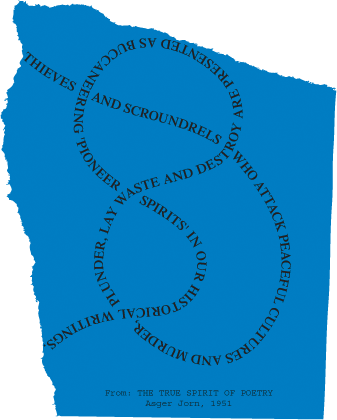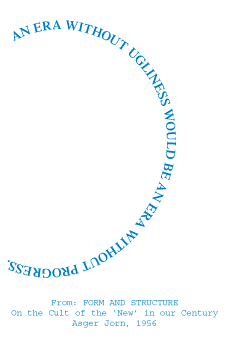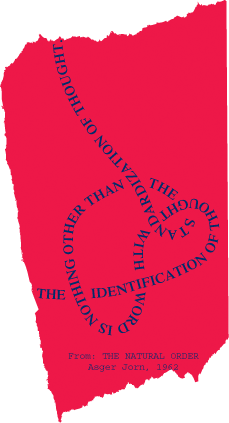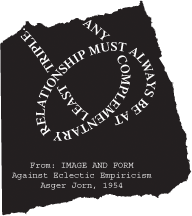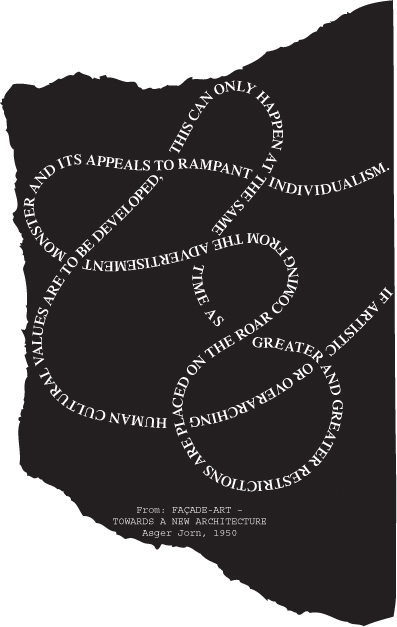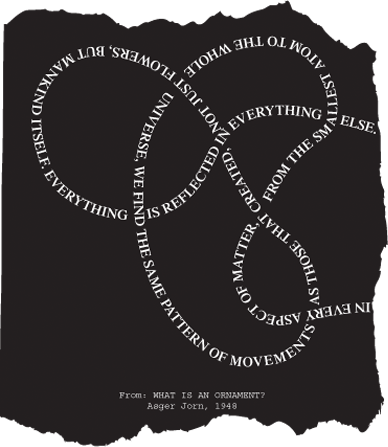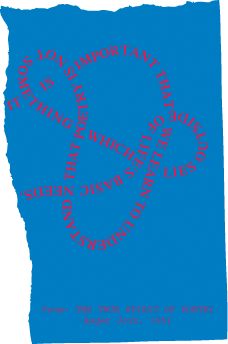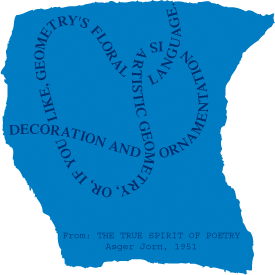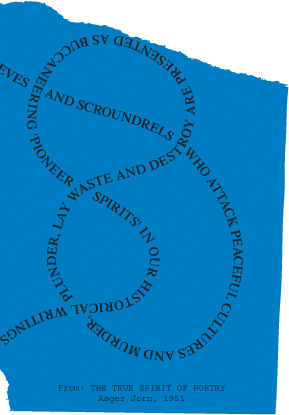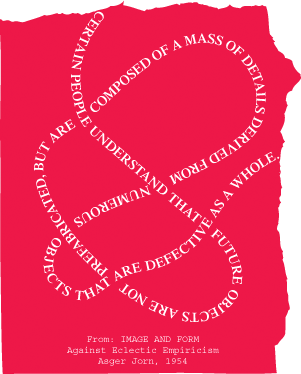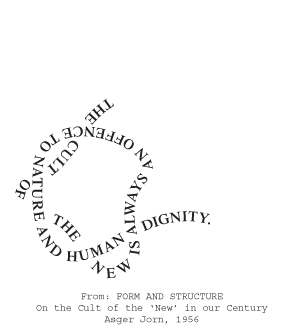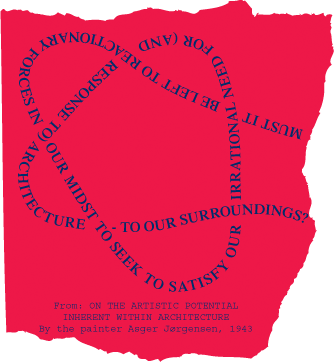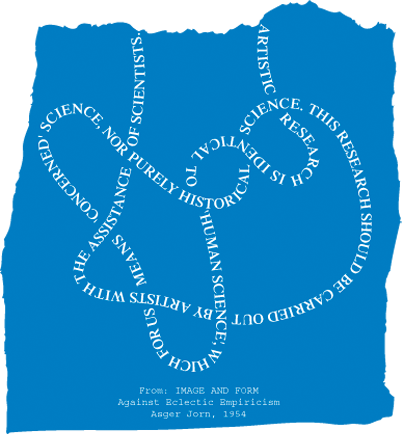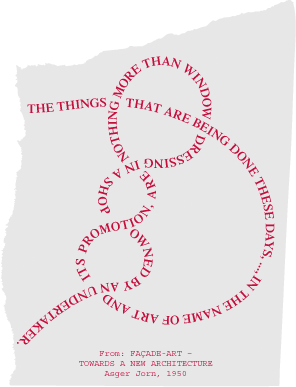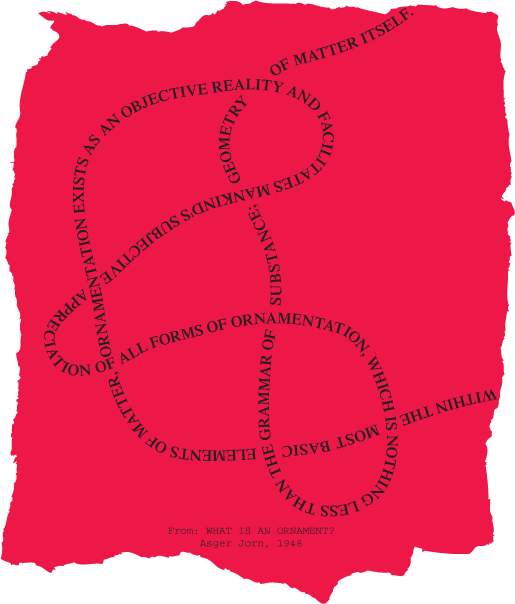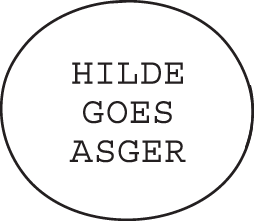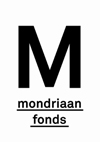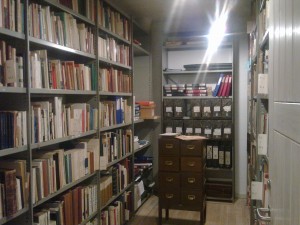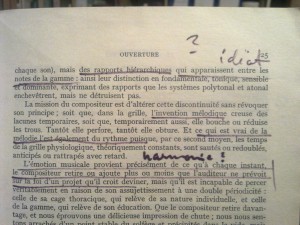YIANNIS ISIDOROU: WHAT ASGER JORN [UN]/TAUGHT ME – A TEXT OF 11 POSITIONS REGARDING THE MOVEMENTS AND TROPES OF THE ARTIST IN THE SYMMETRICAL(IZED) WORLD OF ECONOMY
Within the framework of my research into Asger Jorn´s writing and thinking I organize public and semi-public sessions with special guests at a variety of venues. The guest´s practice, knowledge, insights, or responses are informative to my research, or steer the direction I take on a particular topic. The sessions also often respond to the context of the hosting institution, or to a specific request. Making the sessions public is a way to share and enter into a dialogue with the audiences.
On January 8, 2016 the session ‘Asger Jorn: Thinking in Threes’ was hosted by Circuits and Currents, the Project Space of the Athens School of Fine Art. Two Athens-based artists contributed to this session. Kostis Velonis with the text ‘Alfred Jarry and Asger Jorn: the Epicurean Influence as Social ‘Swerve’ which can be found in the Pataphysics section of this blog, and Yiannis Isidorou with the performance-text below, which consists of a compilation of Jorn citations, partly shifting the original intentions as “to point out some extra risks of today”, to speak with Isidorou.
Yiannis Isidorou’s practice spans a broad range of media including photography, video, sound design and installation. He is co-founder and editor of the Greek e-magazine happyfew.gr on politics, philosophy and art. In 2004 he established Vortex Studio an independent art space and seminar center where he teaches photography and video. His latest project, another co-operation with Yiannis Grigoriadis, called “Salon De Vortex” is a thorough research on democracy, dominance and decay in the post war european society.
1.
Modern science makes us understand the true character of the machine, of rationalization and of standardisation. All of that leads to one thing only: the economy. Economy attempts (is) the symmetricalisation of forces.
Art is to create inequalities.
It is a way of breaking with common taste but also, of reconceptualising it by means of that break, it is a strategy of redescription and re-presentation , a process of hi-jacking. Criticism and affirmation coexist. Imagination, game, awareness, contingency, subversion of the existent.
Every conscious creative act concerns itself with the boundary of self-interestedness and aims at its rapture and containment.
2.
I remain unpredictable at every moment, create the preconditions for surprise and disturbance, I manoeuvre amidst the multitude.
The artist is a chameleon. Lives as the servant of the contingent and the infinite. Bases his cause on nothingness. Moves across the surface, to the margins or even beyond the space defined by consensus, ideology, the common view of things.
Art is not a standard of behaviour but a field of experience.
3.
The reconfiguring of the artist is possible and it is urgent.
What is at stake is a confrontation.
Living art signifies action, it is directly connected to deciding, it negotiates negation, it sets examples and examines multiplicity. The creator’s art is diametrically situated to that of the viewer, the reader etc. Uniqueness, inspiration, scintillation are now the empty signifieds of the dominant spectatorial conception of art. They are the narratives which uphold the ideology of the spectacle. / Art values reality, it is a value investment that reaches as far as the perpetuation of the moment. It renders reality precious in sharp contrast to technique, which disdains it.
The purpose of art is to render human actions valuable, using the means which the current development of the times affords.
4.
I loathe the stock values of the industry: “originality”, innovation, novelty and alongside those, their main instances in the 20th century – work camps, concentration camps and the atomic bomb.
Artistic experiments continue to exist, whereas an experimental field no longer does. That is being endlessly crushed between commercial pusillanimity, resentful controversy and academic hypocrisy.
More and more artists find themselves in an unprecedented impasse and are forced to beg the state for certification, become “prize pupils” and go after distinctions from opportunists the world over, presenting their wares to collectors, institutions, residencies and fairs. Forced to respond to the requirement of constant self-promotion, they regularly make fools of themselves and lose themselves in the neurotic need of acceptance by no-matter-whom.
We thus give away the most precious thing of all – our time.
5.
There is no creative-poetic activation except opposite of society. The social human remains man’s most convincing instance. Despite that / the generality of a social life cannot exceed the tragedy of a private life. Social meaning never does supersede individual’s.
The individual’s enmeshment in the contradictions of the real and its overcoming, reappear as one of the main areas of concern of free artists. A fragmented ‘I’ and a fragmented word may only encounter one another in a way that’s exceedingly contradictory and imponderable. No progress is possible without dire consequences.
6.
Artistic organization is impossible and irrational. Art is anarchy. It is a practice deeply antisocial and it resists organization.
The artist is anti-political. His practice refutes social organization.
It consists in the manifestation and renewal of value differences, hence is sharply at odds with the principle of equality. It attempts increments of progress by experimenting with the discreditation of the existent, without moral prejudice and without defined aims.
What the artist shares with those who are likeminded is the sentiment of rebellion which, however, is changed into a vacant stance (devoid of meaning) when (or as) it evolves into extremism. Every avaunt-guard declaration is finally an eschatology from which we ought distance ourselves, the sooner the better.
Enough already with groundbreaking practices.
The artist seeks the ties that bind the world together. In that regard, he has been abandoned to an apparently useless and futile struggle. Persistence is necessary in order to found a cause on nothingness, on the purely contingent, on the irrational, since wordly forces require a spiritual justification of their power. The ideal of the State.
The activity of the artist in relation to that coercion is the activity of the dexterous burglar-saboteur. He gains an overview of the area, assesses the risk, secures an escape route, works fast, minimizes the duration, blows everything up.
7.
Art is what is discontinuous within the continuity of the world’s narrative. It is an ensemble of incisions and methods whose horizon is the autonomy and freedom of the individual and whose field of development is social becoming.
It is proof of the individual capacity for free action and simultaneously the main means of increasing public nervousness and releasing man’s available energy tensions. Tolerance is the one thing not tolerated in the artistic field.
The construction and projection of a theory of the restrictions, rules, principles or causes for which I create, in short, a narrative of the process of the artistic work, has a soporific effect and, in any case, it lapses into a didactic subterfuge, an educational obstacle on the way to autonomy, to the understanding of social requirements and possibilities of the times. Every promotion of the process ends in pathetic introductions and afterwords.
8.
Availability is the precondition of self-ordained creative activity. Those who have everything to gain and nothing to lose are the artists who are today virtually the only group in the population who retain their total availability unaffected. Several ruses have been enlisted to rescind that availability the outcome is that, even if “artistic production” keeps up, it is void of artistic value.
For the artists who have preserved their free availability and creative capacity, life becomes increasingly dire. One might speak of homelessness. Whoever today chooses or answers the call of free creation, must be prepared in advance for relentless persecution, malignment, pressure and, in the event these do not have the desired effect, lawsuits.
9.
We do not pick our time even if we transform it.
Europe’s cultural production is strictly separated from its society and functions as a central propaganda machine of reality reversal. It is an obscurantism claiming to be an enlightenment. Academia as a movement remains a staunch enemy of art and of the artist. We do not oppose the schools of craft production nor the Fine Arts academies. They are not our concern.
The free artist is a professional amateur. The spirit of amateurism does not signify one is a complete autodidact but, rather, the capacity to overcome one’s knowledge in favor of a new innocence, a new zero starting point or a sense of utter ignorance. Art never provides values but consists in the power necessary to affect and release the ones existing. That is to say, it is a destroyer of human quality and integrity and it is this destruction of perfect integrity that is experienced as beauty. The secret of art consists in the simple fact that it is more beatific to give than to receive but this beatitude hinges on a voluntary offer, on the sense that the offering is considered to be surplus, an abundance and is not motivated by a sense of duty. Art destroys, subverts, liberates.
Oblivion remains our foremost passion.
10.
Only changes attract people’s attention. Creating changes is what is called a game or a variation. To establish a field that operates on the principle of necessity is to annul the possibility of a game or of variations within it.
The game may be considered the foundation of what we call fine arts and this is due to the attraction exercised by the risks to which we are exposed in the course of the game, an attraction requiring an optimal concentration of skill to attain optimal performance.
Only through high stakes may optimal performances derive.
11.
Loneliness is lying in wait for the artist.
During the game, during the concentration of individual skills there are many dangers. The “game” is a closed off narrative.
By contrast to the vastness of the real, it starts, it ends, it has rules.
Life goes on.
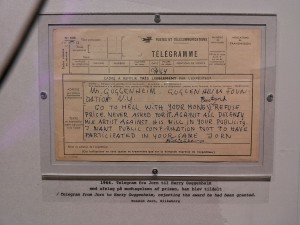
In 1964, Asger Jorn was awarded a Guggenheim Award including a generous cash prize, by an international jury assembled by Lawrence Alloway. The following day Jorn sent this telegram to the president of the Guggenheim, Harry F. Guggenheim : GO TO HELL BASTARD—STOP—REFUSE PRIZE—STOP—NEVER ASKED FOR IT—STOP—AGAINST ALL DECENCY MIX ARTIST AGAINST HIS WILL IN YOUR PUBLICITY—STOP—I WANT PUBLIC CONFIRMATION NOT TO HAVE PARTICIPATED IN YOUR RIDICULOUS GAME.
AUTHENTIC IRONIES
The text below is an interview that was conducted with Karen Kurczynski in May 2015. Karen Kurczynski is Assistant Professor of Modern and Contemporary Art History at the University of Massachusetts, Amherst, USA and author of the recent publication The Art and Politics of Asger Jorn – The Avant-Garde Won’t Give Up, Ashgate, 2014. A slightly different version of this interview is published in the framework of the Art in Context Programme of the Rietveld Academy, Amsterdam in collaboration with the Cobra Museum for Modern Art. The theme for 2014/2015 was ‘laughter’.
HdB: The Danish experimental artist and thinker Asger Jorn (1914-1973) is well-known for being one of the co-founders of the postwar experimental artists’ group Cobra (1948-1951), and the Situationist International (SI), a movement of artists and intellectuals who strove to achieve social change (1957-1972). Many of those who study Jorn’s oil paintings, etchings, lithographies and other work, will find themselves smiling or even laughing about his puns and parodies, ironic or sometimes tongue-in-cheek humor. In your recent publication The Art and Politics of Asger Jorn: The Avant-Garde Won’t Give Up, Ashgate, 2014, the chapter ‘Authetic Ironies’ discusses the critical and expressive operations of Asger Jorn’s mature paintings, including parody. Here, you identify irony, parody and related strategies as a key element to understanding Jorn’s work, as “foundational to the social nature of Jorn’s aesthetic as a whole …”. Are you aware of previous art historical texts which attribute a similar value to Jorn’s ironizing (including self-ironizing)?
KK: This is an interesting aspect for me to consider now, as I work on an exhibition on Cobra for the NSU Art Museum in Florida (which will end at the Cobra Museum). Because Cobra was not interested in irony at all—or at least, that is what Christian Dotremont writes in one of his key texts, “Par la grande porte” (1949, in a catalog from Colette Allendy Gallery): “They are against ironic painting, which actually tries to express the organic joy of the universe, the historic joy of the world of 1949, but which is ashamed and which trims down the aesthetic impulse […] with an elegant little intellectual penknife.” Jorn too was more interested in authenticity in the Cobra years: he associated irony with the ruling class in his large c. 1947 manuscript “Blade af kunstens bog.” He then explored irony along with humorous strategies more and more over the course of the 1950s. In fact he was always interested in humor in art and in writing, co-authoring a parodic article on a Functionalist named “Everclean” in 1948. Already in his 1952 text Held og hasard, a very Nietzschean text, he rejects the idea of authentic expression. Then by the mid-50s, he openly espouses irony and “lying.” Historiographically, this is precisely the moment his art work begins to be celebrated on an international stage. The critics and curators like Werner Haftmann who wrote about it, however, emphasized it as a return to angst-filled expressionism. Contemporary critics especially in the US, where Jorn’s work is less well known, have continued to dismiss his work as expressionist (or worse, neo-expressionist—ironic and therefore empty) until very recently, after 2000. There are not many art-historical texts that place a high value on irony per se or self-ironizing in Jorn’s work until very recently, when suddenly that issue is becoming ubiquitous. I can’t think of any writer or curator who took his irony seriously until the 21st century, and now I can’t think of any who don’t take it seriously. Those who knew Jorn personally, like John Lefebre and Lawrence Alloway, certainly commented on his humor. It is really the writers you and I know now, our colleagues like Helle Brøns and Axel Heil, who are bringing this aspect into sharper focus today. It’s also related to the evolution of art historiography in general. Jorn (and Cobra) were not taken seriously because their work wasn’t perceived as “serious”—one of the most important key terms in postwar movements like Abstract Expressionism—so writers like Haftmann and Guy Atkins had to present his oeuvre as a serious engagement with major artistic themes. We are in a very different, much more interesting, moment now when artists contribute more writing on art and have helped influenced art critics and historians to recognize the importance of humor and play.
HdB: Irony and parody could be looked upon as a highly self-defensive modes, allowing someone to avert responsibility, to be indirect. However in the title of your chapter the words ‘ironies’ and ‘authentic’ are happily married. This seems to be a contradiction in terms but reading the chapter reveals that you locate the actual criticality and complexity of Jorn’s strategy in the dynamics between both elements. I would be curious to learn more about your perspective on the development of these dynamics. The ‘Authentic Ironies’ chapter discusses parody as a critical operation mostly in relation to work from the end of the 1950s into the 1960’s but (as you also mention) the concepts of irony and artifice are part of the development of Jorn’s aesthetic theory from the Cobra period (1948-1951) onwards. May I ask why you felt it was necessary to make this chronological distinction?
KK: The chronological distinction is really just part of the structure of the book, which focuses each chapter around a theoretical issue (in this case, expressionism and irony) combined with a particular temporal and artistic focus (in this case, Jorn’s mature painting ca. 1957-62). Jorn is interested in humor and play in art from the beginning, from his 30s Miró- and Klee-inspired works onward through Helhesten and Cobra. But I focused on different issues in my accounts of the earlier periods. Also, as I just mentioned, Jorn’s humor and irony come out much more explicitly in his late 50s and early 60s work than at any other period. Each chapter of my book has a title which is a deliberate contradiction, an oxy moron, in a Jornian spirit. It’s the clash of Jorn’s irony in a postwar age so obsessed with authenticity that gives his work such interest, and his position seems newly significant to us now as artists are returning to issues of abstraction and gestural painting but in an extremely sophisticated and sometimes overtly political way, combining abstraction and expressivity with some of the irony associated with pop art, appropriated imagery, and now digital mash-ups—when in the 50s and 60s those two approaches were strictly separated by generation. Recent artists are more interested in combining the best of both generations—the spontaneity and human element in the gesture, but without making it too specialized or spectacular; the humor and sophistication of using appropriated imagery but without it being too easy or celebratory. Jorn’s work does all of this. Today we have a much more sophisticated, “situational” understanding of identity and authenticity in the internet age, and new recognition of the importance of play in the era of video games and “gamification,” that I think makes Jorn’s work seem prescient and newly relevant.
HdB: The following question I have appropriated from a conversation with Jouke Kleerebezem, one of the tutors of the Rietveld Art in Context programme. He was wondering if we could touch upon the type of ambiguity that typifies humor in general, making the ‘laughter’ that results from it an acquired taste, always debatable between those who differ in their sense of humor. So then I wondered if you think Jorn shot himself in the foot every once in a while, and whether he perhaps did not care?
KK: Did Jorn shoot himself in the foot sometimes? Yes. Did he not care? No he did not care. His hits were so on target that I think they excuse a lot of misses that would stand out more in the work of an artist whose work was less complex and multifaceted. He always kept moving which is one of the fascinating things about his work and his artistic practice—it was also a source of heartbreak for those around him, from his wives and girlfriends to his kids, who suffered immensely, and his friends and gallerists. In terms of his humor, take a work like Masculine Resistance at the Museum Jorn, and you can see the retrograde gendered assumptions about the interaction of men and women that make its humor sort of fail from my own feminist perspective today (Helle Brøns has written about the gender confrontation in this work). But at the same time, the failure is itself interesting. It has something to tell us about mainstream gender attitudes in Jorn’s day, on the one hand, and it has a very critical message about the discourses of authenticity and transcendence that characterized art in his day, on the other. Its emphatic vulgarity in both how it was painted and the subject itself is a biting critique and a liberating rejection of the abstract painting that was dominant at the time. So it’s not humor as in a joke, which is always socially divisive (some of the best comics are the most offensive ones—Sarah Silverman for example). It’s more like meta-humor because the humor is always embedded in multiple and contradictory discourses. Jorn’s work is humorous in a way comparable to Richard Prince or Glenn Ligon’s “joke” paintings, which repaint a racist or sexist joke on a monochrome canvas, despite their radically different aesthetics. Whether you laugh at the joke is only part of the point—it makes you stand back and start thinking about what it means to laugh at it in different contexts, as well as (and this is key) the fact that the joke is always so culturally specific that it’s immediately outmoded and, well, no longer funny. So even Jorn at his most sexist or short-sighted has potentially important meanings for us. At the same time, just to negate everything I’ve just said (another Jornian move), I think you can also find passages of sheer physical humor in Jorn’s paintings that might be more universal—the way physical comedy appeals to a wider audience. You can also find references to carnivalesque themes and popular humor as seen in earlier painters like Bruegel and Bosch, and writers like Rabelais who Jorn loved. There are many different forms of humor present in Jorn’s work.
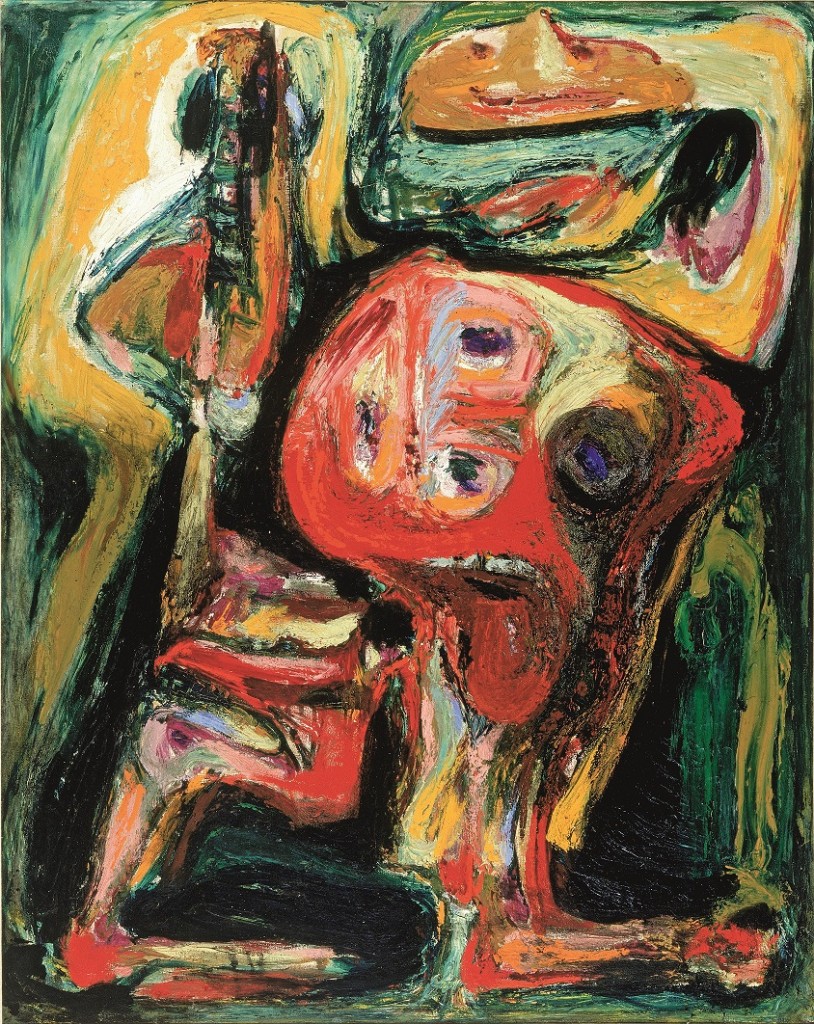
Asger Jorn, ‘Le faux rire (image tragi-comique)’, oil on canvas, 1954. Longterm loan by ABN-AMRO to the Cobra Museum of Modern Art, Amstelveen. Photograph: Henni van Beek
HdB: In 1954 Jorn made an oil painting that literally depicts laughter: Le faux rire (image tragi-comique) which translates as The Fake Laughter (tragic-comic image). At the bottom of the painting we see a (literally) two-faced laughing character in a slightly awkard, half-reclining position while holding something up in the air with one arm. In the background above the laughing character hovers a smaller, friendly looking face. Although the painting is the representation of a fake emotion it funnily enough simulaneously brings across a genuine emotion, the mix of twisted feelings that potentially come with a fake laugh (discomfort? repulsion?). I would like to invite you to closer examine this painting from the perspective of ‘authentic ironies’. In relation to Jorn’s paintings La double Face (The Double Face) and Le Cri (The Scream) you for instance bring up notions such as multiplicity, clichés of the representation of human emotion, the understanding of complexity of the self as a social situation, and Jorn’s insistence on meaning-production as an active process.
KK: This is a great work to bring into focus the complexity and multiple dimensions of laughter we just touched on. The image strikes me as very grotesque in its combination of comic and tragic—humor and angst—in a particularly puzzling combination. The history of the grotesque from ancient times (when it was called the “monstrous”) to the present, as many scholars have demonstrated, typically combines humor with horror. So it relates to a prominent theme in human culture. We can all think of examples of situations that are horrible or harmful that, when considered at a remove, can also be really funny (though at the time it was still largely taboo in Europe to produce humorous imagery relating to the Second World War—Jorn’s work plays with those taboos only indirectly). This image features not just those two dimensions of tragedy and comedy, but also a third, the question of “fake” laughter. The issue of something fake destroys any notion of authenticity and cuts through any attempt to securely define something. Then, Jorn began his painting Stalingrad, le non-lieu, ou le fou rire du courage, the same year—the first title of that painting was “Le fou rire” (Mad Laughter) and it may or may not have been a reference to history or history painting or the “mad laughter of courage” in an epic battle at that point. It acquired the title Stalingrad a bit later. Jorn loved puns and I think it’s likely that he linked le fou rire and le faux rire together deliberately. Fou being a reference to an authentic expression; faux indicating irony and inauthenticity. What strikes me about this image is that it seems more troubling than funny, so is it about laughter at all? Or really, it’s precisely about laughter rather than explicitly funny. It is about the significance of laughter. Laughter and play are elements that rational society suppresses and they indicate a critical distance, a resistance to power. They are also intimately linked to creativity itself and the ideas of play and experiment so prominent in Cobra. Laughter indicates a double perspective. The main figure is not just laughing, but sticking out his tongue, which is a gesture of childishness, defiance, as well as disgust; a gesture referenced earlier in Cobra and examined in Jorn’s later book La langue verte et la cuite. The material fleshiness of the painting is also striking. Parts of figures evoke blood and bones, the mouth and the tongue, the eyes made grotesque as they multiply and roll in all directions. It’s an image of illness (recalling Jorn’s abstract portrait of his injured cousin Mads in the Silent Myth murals) and madness, so strongly linked to creativity. It’s also a visceral painting that affects us in an almost physiological way. As it was made in Italy, this was part of Jorn’s reaction against the sleekness of postwar design culture and his investigation of ceramics at the time. It’s a great example of his interest in Bachelardian ideas of the “material imagination.” It is grotesque because it fails to cohere as a recognizable group of figures. Instead it conveys the process of signification. Maybe it even conveys the process of creating humor itself, and its flipside, tragedy itself, out of the neutral facts of what happens in the world. There is also a recognition implicit here (but signified by the contradictions inherent in the title) that the process of signification is always social. So what one calls greatness, another calls tragedy, and yet another calls humor.
ASGER JORN: THE SECRET OF ART
The text below is also part of the publications Asger Jorn: the Form and Beyond, edited by Luca Bochicchio and Paola Valenti, Genova University Press, Italy, November 2014, and Asger Jorn: The Secret of Art, Cobra Museum of Modern Art, Amstelveen, The Netherlands, 2014 (limited edition, designed by Richard Niessen).
The public sessions in the framework of hildegoesasger.org at the Athens Biennial 2013 and at Casco, office for art design and theory in Utrecht early 2014, built the basis for this text.
After having worked exclusively with contemporary art for about ten years, I started a job as a curator at the Cobra Museum of Modern Art in the winter of 2011. This called for refreshing my knowledge of Cobra, the loose constellation of young left-oriented artists and poets that officially existed from 1948-1951. The energetic Danish experimental artist and thinker Asger Jorn (1914-1973), well-known as a painter and a co-founder of Cobra and one of its driving forces, attracted my special interest. He was always on the move looking for international exchange and discussions, creating collaborative work, magazines, and exhibitions. What I have learned since 2010 is that Jorn, with great thrive and ambition, also wrote numerous books and articles envisioning, from an artistic point of view, ‘the first complete revision of the existing philosophical system’.
In his writings Jorn combined ideas from a wide variety of disciplines including politics, physics, economics, philosophy, anthropology, structuralism and art theory. The way he brought these various interests together in complex and unconventional ideas and ways, in search of a comprehensive theory of art and life, appeals to me for various reasons; especially his strong ideas on art as not derived from an ideology or worldview, but as the direct expression of an attitude towards life, belonging to the fundamental level of work and production. Jorn’s views result in a very outspoken position in the philosophical debate about the value of art and the position of the artist in society. In this perspective, art historian Graham Birtwistle makes the crucial observation that: “(…) in placing [art] at the basis and not in the superstructure, Jorn’s theory gives to art both a primary role and a certain independence from conventional ideological idealism.”[1]
Over the past years (and currently) the value of art and the position of the artist in society has been a much discussed topic in several European countries. Politicians announced budget cuts and other vigorous measures for the cultural sector in the light of the (ongoing) credit crisis. I wondered if the questions that Jorn posed and the position he took could still be relevant for the analysis of our current situation. Could Jorn’s theory, and more important his (art) practice, give us “certain independence”, as mentioned by Birtwistle, with our society transforming at a rapid pace from ‘market economy’ to ‘market society’?
After reading an essay by the Belgian sociologist Pascal Gielen I realized that Jorn, who had strong political views and anti-capitalist ideas, might have shared Gielen’s perspective on the current situation in Western society as one of ‘repressive liberalism’.[2] He defines repressive liberalism as a situation in which the state embraces ‘freedom’ and the ‘free market’, whereas the control of that freedom has in fact increased. The result is an extremely conditional form of freedom, or freedom as an instrument of control. Within this, Gielen says we are facing a situation of political dialectics replaced by a bureaucratic middle class that aspires to a measurable and controllable mediocrity.[3] Indeed a contemporary echo of Jorn’s words:
“For an elite to have real power it must have rights and regulations other than the rest of the population, it must form an extraordinary order. As this monopoly is abolished in modern democratic society, the administrative posts can only be occupied by the best amongst the mediocre, chosen from the good citizens. The disorderly and the extraordinary, the poor and the best are excluded automatically … .”[4]
Gielen also states that in fact, the past ten years the jargon of liberalism has been embraced with surprising and quite uncritical easiness, using politically charged language (including terms such as culture consumer, entrepreneurship, marketing) as if it were neutral, as if it were devoid of an ideological signature. He points out that anyone who nowadays opposes the rhetoric of repressive liberalism is labelled a naive romanticist. Isn’t this perhaps one of the major problems with what Jorn has to offer us as well? That it is hopelessly romantic? What could be distilled or taken from Jorn’s way of thinking to practise a genuinely critical art towards culture in our times?
The spice of life
Not surprisingly, Jorn never showed any hesitance in advocating and claiming an essential role for the arts in life and society. He wrote:
“What we are talking about here is art and its justification, its meaning and its place in our lives and society. Art does not exist simply for the enjoyment of beauty, nor to point a moral finger. Aesthetics and ethics are nothing more than playthings for philosophers and theologians. Art is a life and death issue; a human necessity. What I am referring to here is the creative, artistic urge and its sets its stamp on all our actions (…). There are core life values which can only grow in freedom, and only when truly free can they form a central part of the way we lead our lives.”[5] He even goes as far as to claim that: “There is a widespread misconception that one’s daily bread takes precedence over the spice of life and that we must all have practical homes before we can even start thinking about putting up frivolous buildings.”[6]
With the above statement Jorn wasn’t simply trying to advocate freedom for the arts for the sake of the arts. In all his texts he kept on expressing in various ways that this freedom was essential to be able to experiment and consequently essential to the generating of new knowledge. According to Jorn, this made it crucial for human society and the human race to develop further. In order to do so artists would need, what he called “free or unused energy”, which he identified as a potential scarcity in a (capitalist) society that claims all available energy. Almost cheekily, Jorn added that strictly speaking, the arts are not necessary. It only is if one desires progress. And if so, one of Jorn’s prerequisites to opening up the possibilities for an effective utilisation of the artistic possibilities would be “that society can afford, and is at liberty, to give architects and artists a free hand in the creation of the best environment for mankind.”[7]
The give-and-take between artist and society was of great concern to Jorn, as this citation also shows. In “Value and Economy …” he reflects on the topic at length and states that artists (and other cultural producers) are in fact exploited by the power elite and that “Art and culture retain only a minimal part of the sums that they earn”[8] as artists and other makers are not paid for their hours of productive work. He builds up his arguments in great detail but it might be most effective to present his example: “If the Americans just paid according to the tariff for the time they occupy themselves with European culture, then the whole of Europe could live off it.”[9] It would be obvious to conclude that Jorn simply argued that from now on artists and other makers should be paid for their hours of productive work[10] (especially as he also stated that the aim of his text “Value and Economy …” is to demonstrate the economic basis that ‘the creative elite’ is entitled to), but he loved undermining and contradicting, and his arguments often had an unexpected twist. In this case he ends the very same paragraph by saying that if what he suggests would be realized, it would have the (I take it as undesirable) effect of “stagnation of our artistic culture”.
Jorn obviously was well aware of the fact that art has a lot to do with economics, at the same time though he often pointed to those aspects that can’t be measured in money:
“Art is a life form. It is mankind’s celebration (and maledictions on) all aspects of life that enliven us. Architecture is the framework upon which we build our lives but the arts are the living framework around life itself. Artistic creation is the spiritual and psychological sea in which we swim and which provides life-giving nourishment.“ [11]
It is in social interaction and spiritual immeasurable values that we can find what Jorn calls “the secret of art”:
“The secret of art consists in the simple fact that it is more blessed to give than to take, but also that this blessedness is dependent upon voluntary giving, so that what is given is felt as a surplus, a wealth, not a duty. This is the simple materialistic explanation of the value of the art work and for all other things called spiritual values. In relation to the practical values, art is thus a counter-value, the value of productive pleasure. Art is the goal for a discharge of energy without a precise goal, except the one that the receiver can discover. In this way, art is the source of benevolence, is what is called grace.”[12]
Holistic as this may sound, the artistic strategies that Jorn applied make him the exemplary model for the recalcitrant modernist artist to whose strategies contemporary artists – “problem solvers of social problems on a micro level (…)” – should return, according to Pascal Gielen. No safety, order and comfort, no self-management disguised as cultural entrepreneurship for the sake of calculability and controllability,[13] but the creation of problems and “creative destruction” is what Gielen calls for. It is true: “Asger Jorn loved difficulties. If there were none, he created them, for himself and others”, writes Wieland Schmied.[14] Risk was also an extremely important element in Jorn’s thinking and strategies, and certainly not a factor that he wanted to reduce to acceptable proportions, in the ‘entrepreneurial’ sense. “(…) I have never been interested in going anywhere unless I was able to go all the way to the extreme”[15], Jorn said. Gielen’s call for creative destruction bears strong similarities to Jorn’s fascination for vandalism as a potential creative act, and his (and those involved in the Situationist International) well-known strategy of ‘détournement’ – basically the adaptation of or variation on previous ideas or works, in which the newly created has a meaning that differs from the original one.
These and other artistic strategies worked very well for Jorn and the other people he was associated with, but as stated in the preface of Collectivism after modernism, recently reborn collectivism has little or none of the leftovers from its own rich past.[16] Rather than looking into specific artistic strategies that worked well for artists in the Cold War era (and which might or might not work well here and now), I suggest that we take two elemental questions to heart. The first question is whether we can find the inner conviction that art is an elemental need (and if we have the willpower, or are prepared, to put this idea into practice).[17] The second one has to do with the idea “that artisthood is not an individual fate (…) but can rest on a collective foundation of solidarity structures”,[18] as Gielen phrases it so rightly.
Perhaps this is a good moment to remember the lifelong stipend that Jorn passed on to the Belgian poet Christian Dotremont, and to bring up Jorn’s donation of over 1,500 art works by various artists to the city of Silkeborg (today at Museum Jorn). Or the donation of his premises in Albisola, Italy, to the community, on the condition that his artist-friend Alberto Gambetta could continue living there until his death and that it would become a public venue after that. These examples not only testify to what looks like solidarity (or generosity) in various of Jorn’s actions. They also point to Jorn’s “second prerequisite to an effective utilisation of the artistic possibilities”: the artistic prerequisite,[19] to which collaboration between artists is a pre-given.
To Jorn collaboration and ‘brotherhood’ were vital and primary artistic solutions. Within these collaborations he regarded disciplinary boundaries of no importance, he rather advocated their abolition. He also rejected the idea of making compromises – so that everyone involved in the collaboration can give his best. The artists involved would share, what Jorn calls “the language of the new age”.[20] He wrote:
“It is the change-over to another rhythm of life in which the essential thing is not the emphasis on the private, the masterpiece, the individual, … not the division of life into closed-off forms, rubrics and classifications, but life’s own rhythm, luxuriance and free growth …,”[21] or: “it is not just a matter of creating an organic, living and cohesive architectural style, but also of creating a living lifestyle, an organic collaboration between human beings – an organic society in effect.”[22]
What is important to add is that to Asger Jorn, the idea of an ‘organic collaboration’ (or any other idea for that matter) takes the subjective, irrational side of human nature into account. To answer one of my initial questions: I can only agree with Jorn that this ‘romantic’ approach is in fact truly realistic.
Let us return to the second question: How to practise a genuinely critical art towards contemporary culture today? Perhaps it is not too far fetched to claim that in our individualistic society, focused on specialization and demarcation, collectivism by its very nature is genuinely critical (towards the art world’s system of individuality in particular). In her essay ‘Internationaleries – Collectivism, the Grotesque, and Cold War Functionalism’ Jelena Stojanović writes about influential European collectives which were all, with the exception of one, co-founded by Jorn: Cobra, International Lettriste, Mouvement pour un Bauhaus Imaginiste, and the Situationist International. She points out that they:
“took upon themselves the immense and utopian task of reimagining collective subjectivity. That is, of redefining the very notion of utopia for the cold war era, a time when the “colonization of everydayness” first took on an unconditional presence. They sought to achieve this gargantuan task by employing what they believed was the only available tactic: a critical art practice, informed by the cold war in which negation, debasement, and blasphemy were discharged against all highly promoted cultural values including “art”, but also the “avant-garde”.”[23]
Perhaps the second question to take from Jorn and his co-conspirators is whether we are up to reimagining collective subjectivity in a time of repressive liberalism.
[1] Graham Birtwistle, Living Art – Asger Jorn’s comprehensive theory of art between Helhesten and Cobra (1946-1949), Reflex, Utrecht 1986, p. 55.
[2] Pascal Gielen, “Repressief liberalisme – Over kunst, markt en cultuurbeleid in Nederland”/“Repressive Liberalism: The Dutch Cultural Policy System” (summary in English), Kunstlicht (no 1/2, 2013). Translations are my own and I refer to the Dutch text.
[3] Dito, p. 14.
[4] Asger Jorn, “Value and Economy – Critique of political economy and The exploitation of the unique”, published in French in 1959 by the Situationist International. In 1962 Jorn published “Value and Economy …” as Report no. 2 of the Scandinavian Institute of Comparative Vandalism. I refer to Peter Shield’s English translation in The Natural Order and other texts, Ashgate, London 2002, p. 203.
[5] Asger Jorn, ‘Architecture is not art’, 1943 translated by Paul Larkin in: Ed. Ruth Baumeister, Fraternité Avant Tout – Asger Jorn’s writings on art and architecture, 1938-1958, 010 Publishers, Rotterdam 2011, p. 53.
[6] Dito. Jorn’s words were not empty rhetoric, he and his family lived in very poor conditions for a long time. He was seriously undernourished by 1951, indicated as one of the reasons for him to get tuberculosis, and when he moved to Albisola, Italy with his family they lived in a tent along the riverside for a while.
[7] The painter Asger Jørgensen, ‘Notes on the Way’, 1945, in Baumeister, p. 82.
[8] “Value and Economy …”, p. 190.
[9] Dito.
[10] He literally meant that if I would amuse myself for one hour with a piece of art, a boxing match, chess game and so on, I would owe the maker/entertainer one hour of productive work.
[11] Asger Jorn, “Face to Face”, 1944, in Baumeister, p. 66 and 67.
[12] “Value and Economy …”, p. 184.
[13] Gielen, p. 14.
[14] Wieland Schmied, ‘The Graphic Artist Asger Jorn’, in Asger Jorn: The Secret of Art, Cobra Museum for Modern Art, Amstelveen 2014, p. 37.
[15] Asger Jorn, ‘Against Functionalism’, 1957 in Baumeister, p. 278.
[16] Ed. Blake Stimson & Gregory Sholette, Collectivism after modernism: the art of social imagination after 1945, University of Minnesota, Minneapolis/London 2007, p. xii.
[17] In line with this and Jorn’s concept of “a living art” Gielen mentions the need for artists who are capable of translating their strategies into “actual life forms” (werkelijke levensvormen).
[18] Gielen, p. 18.
[19] Asger Jorn, ‘Notes on the Way’ in Baumeister, p. 82.
[20] Dito, p. 83.
[21] Asger Jorn, ‘Formsprakets Livsinnehåll’ (The lifecontent of the language of form), Byggmåstaren, Stockholm, XXVI, 17, 1947, in Birtwistle, p. 317.
[22] Asger Jorn, ‘What is an ornament?’, 1948 in Baumeister, p. 206.
[23] Stimson & Sholette, p. 38.
JORN AND THE PRESENT
“The artistic impuls is the central locus of our imagination and intuition. It is this which unites our realities with our potential; the existential with that which does not exist; the thing that was but is no longer; that which is to come but has not yet arrived; the possible with the impossible. It is the thing which enables us, as it were, to lift ourselves above questions of time and place. This is something existentially fundamental in our nature, because it strengthens our will to live and create.” Asger Jorn, ‘On the Artistic Potential Inherent in Architecture’, 1943.
Asger Jorn (3 March 1914–1 May 1973) was born Asger Oluf Jørgensen in Vejrum, in the northwest corner of Jutland, Denmark. He was a painter, sculptor, ceramic artist, and author/thinker, and is well-known for being a founding member of the avant-garde movement Cobra and the Situationist International. What I wasn’t aware of, is that throughout his career Jorn wrote over 700 articles and books in which, or through which, he attempted no less then to undertake ‘the first revision of the existing philosophical system’. Jorn himself read a lot, and by the time of his death he possessed a considerable amount of books, of which around 1600 are archived in a modest-sized room in the Museum Jorn in Silkeborg.
In March 2012 I had the opportunity to walk into that room, which felt a little bit like walking into Jorn’s head, and I spent a great couple of hours browsing through books on aesthetics/art theory, philosophy, mathematics, structuralism, religion, folks art, medieval art, archeology and more.
Jorn regularly underlined passages, and seemed engaged in an intense (internal) dialogue with some authors. While reading Claude Levi-Strauss’s structuralist theories in the book Le Cru et le cuit (1964), he must have particularly wound himself up, and I had a great laugh taking this picture:
It was in the Summer of 2011 that I became more aware of the extend of Jorn’s philosophical output. More or less simultaneously I came across a text on Jorn’s Nordic Institute of Comparative Vandalism, and a compilation of his texts on art and architecture, recently published by 010 Publishers, Rotterdam (Fraternité Avant-Tout, Ed. Ruth Baumeister). Here, Baumeister lists a few of Jorn’s interests and undertakings, ranging from “a reinterpretation of Marxism as a cultural-political theory, critiquing the concept of unitary urbanism, advocating an immediate life experience based on human life and passion instead of capitalist order, safety and comfort, and the dominance of the image in mass media…” . What struck me most reading those texts is the organic way Jorn dealt with everything, and how he eventually integrated his thinking in an all-encompassing theory on art and life, based on a very outspoken position in the philosophical debate about the position of the artist in society. His various attempts to co-operate across boundaries of culture and thought in order to expand our field of visual knowledge are fascinating, and believe it might very inspirational to revisit some of these projects.
There have been a few issues in particular that I have been especially interested in from the outset. For instance, I am already thinking for a while about a project in which the notion of decoration and the ornament (so heavily influenced by classic modernist, functionalist ideas) would be revisited. Could Jorn’s description of “the tragic history of the ornament in art” and “the economy of ornamentation” (where he proposes a link between economic and artistic crises) be informative in that? What could we say about the status of the ornament in a time where populist politics is on the rise, and we clearly did leave it “to the reactionary forces in our midst to respond to our irrational needs …” (Jorn)? And how do his ideas on vandalism as a potential creative force, and the clear distinction he made between the subjective and the personal built a starting point for any kind of creative thinking and making in current artistic and discursive practices? How can we contextualize his ideas on history and history making to the current interest in revisiting modernist practices? This blog is a platform for exchange and dialogue between professionals from various disciplines, on these and other questions, and will hopefully lead to more in-depth analysis and creative responses throughout the coming period.
